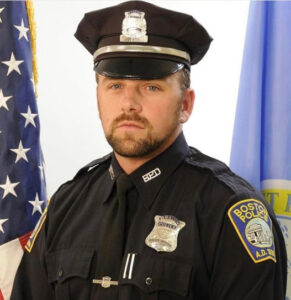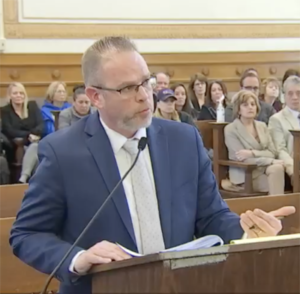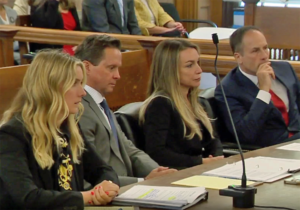Commonwealth vs. Karen Read: What do we know?
By Jay TurnerAfter nearly two years of legal wrangling, public discussion, and rampant speculation, the question of Karen Read’s guilt or innocence will be decided once and for all by a jury of her peers in a trial that commences on Tuesday, April 16 in Norfolk Superior Court. What follows is a summary of everything we know about the case based on our review and coverage of the pre-trial process.
Who is Karen Read and what crimes has she been charged with?
A Mansfield native, Read, 44, will stand trial this month for the alleged murder of her boyfriend, John O’Keefe of Canton, who was found unresponsive in the snow on the front lawn of a home at 34 Fairview Road in the early morning on January 29, 2022. Prosecutors allege that Read, who they say was intoxicated when she dropped off O’Keefe at the residence to attend a party, struck him with her SUV at a high rate of speed before fleeing the scene and returning to O’Keefe’s home. She was arrested days after the incident on a manslaughter warrant, and in June of 2022, a Norfolk County grand jury formally indicted her on charges of second-degree murder, manslaughter while operating under the influence, and leaving the scene of a collision causing injury/death.
Prior to her arrest, Read had worked as an equity analyst at a financial firm and as an adjunct professor of finance at Bentley University. She had been dating O’Keefe for approximately two years, dividing her time between Mansfield and Canton.
Where is Read now?
Read remains free on bail pending the outcome of her trial, where she will be represented by a three-person legal team consisting of David Yannetti, a Boston-based criminal lawyer, and Alan Jackson and Elizabeth Little, who are both partners in the Los Angeles-based firm of Werksman Jackson & Quinn LLP. If convicted on the murder charge, Read would receive a life sentence with the possibility of parole after 15-25 years. She also faces between five and 20 years on the motor vehicle manslaughter charge and up to two years on the charge of leaving the scene.
Who is the victim in this case and what are his ties to Canton?
Originally from Braintree, O’Keefe moved to Canton and assumed a guardianship role for his young niece and nephew following the deaths of both of their parents — O’Keefe’s sister and brother-in-law — just months apart from one another in late 2013 and early 2014. A recent Boston Globe story notes that he had been single and living in Dorchester at the time, but without hesitation or fanfare, he “morphed into a suburban dad practically overnight,” adjusting his work schedule to better support the children, who were then ages 6 and 3.
At the time of his death, O’Keefe had served for nearly 16 years as a Boston Police officer and was perfectly suited to the role, according to friends and loved ones who spoke to the Globe. A graduate of Northeastern University, O’Keefe went on to earn his master’s degree in criminal justice from UMass Lowell and previously spent time as an auxiliary police officer in Duxbury and Falmouth.
What circumstances brought O’Keefe to Fairview Road on the night of January 28, 2022?
Based on the testimony of several witnesses, O’Keefe and Read had gone out for drinks in Canton Center, first at C.F. McCarthy’s and later at the Waterfall Bar and Grille, where they met up with a group that included friends and acquaintances. As the bar began to close, Brian Albert, who was also a Boston Police officer, invited the group back to his home on Fairview Road, and O’Keefe agreed to join them. Shortly after midnight, witnesses inside Albert’s home reported seeing Read’s Lexus SUV pull up to the front of the house, then move to the edge of the property before driving off a few minutes later. Read said she saw O’Keefe walk up the driveway and approach the door, but none of the witnesses reported seeing O’Keefe or hearing from him for the remainder of the night.
When and where was O’Keefe’s body found?
According to court documents, O’Keefe was found shortly after 6 a.m. on January 29, 2022, on the edge of Albert’s property by Read, who had returned to the area to look for him along with Jennifer McCabe, who had been out with them the night before, and Kerry Roberts, a longtime friend of O’Keefe’s. McCabe called 911 while Roberts and Read attempted CPR on O’Keefe, who was unconscious and had visible injuries to his face.
What evidence does the prosecution have to support their theory that Read killed O’Keefe?
Prosecutors have pointed to a combination of physical evidence and witness testimony to support their case against Read and have expressed confidence in their ability to secure a conviction.
Physical evidence: Investigators collected pieces of red and clear plastic at the scene that they said were consistent with the broken passenger taillight found on Read’s SUV. They also found O’Keefe’s DNA on the broken taillight and recovered microscopic pieces of red and clear plastic from O’Keefe’s clothing that lab tests showed were consistent with the broken pieces of plastic from Read’s taillight.
Witness statements: Both McCabe and Roberts told investigators that while driving with Read to search for O’Keefe, Read wondered out loud whether she could have hit O’Keefe with her vehicle and stated that she had a crack in her taillight. Roberts also indicated that when Read called her that morning, she expressed concern that O’Keefe was dead and mentioned the possibility that he was hit by a plow driver. She also reportedly claimed to have no memory of the previous night and later told a Canton paramedic on scene, when asked what had happened to O’Keefe, “I hit him, I hit him, I hit him.” Additionally, the victim’s niece told investigators that Read changed her story several times while speaking to McCabe on the phone on the morning of January 29.
What have prosecutors said about a possible motive for Read?
In written filings and oral arguments, prosecutors have sought to establish a pattern of growing disharmony in the relationship between Read and O’Keefe, citing interviews with O’Keefe’s niece and nephew and witness reports of conflict during a trip to Aruba a month before O’Keefe’s death. Witnesses say Read suspected O’Keefe of cheating, and the grand jury was shown copies of texts between Read and Brian Higgins — who had been at the Waterfall bar and later at Albert’s house on the night of January 28 — that were described as “romantic in nature.” Prosecutors have also recovered text messages that Read and O’Keefe exchanged on January 28 concerning their “strained relationship” as well as angry voicemails that Read left for O’Keefe after she had left Fairview Road.
What is the basis of Read’s defense?
Read has pleaded not guilty to all charges and her attorneys are pursuing a third-party culprit defense, alleging that O’Keefe was murdered inside Albert’s home by one or more partygoers. Those individuals, according to Read’s attorneys, then took steps to cover up the crime, conspiring with investigators to pin the blame on Read. They also allege that prosecutors in the Norfolk DA’s office have been complicit in the cover-up by withholding potentially exculpatory evidence, disregarding conflicts of interest, and publicly declaring Read guilty while vouching for the credibility of witnesses.
What evidence do they have to support their claims?
While prosecutors vehemently deny the accusations made by the defense team, Read’s attorneys believe they have more than enough evidence to establish reasonable doubt and ultimately warrant a dismissal. Examples include:
* Analysis of phone health data that appears to show O’Keefe, upon arriving at 34 Fairview Road, taking 80 steps and climbing the equivalent of three flights of stairs.
* Testimony from experts, including an accident reconstructionist hired by federal investigators, that conclude that injuries sustained by O’Keefe were not caused by a motor vehicle collision.
* Statements given by Brian Loughran, a Canton DPW plow driver, indicating that there was no body on the Alberts’ front lawn when he passed by the home at approximately 2:30 a.m. on January 29.
* Evidence of longstanding prior relationships between the Albert family and CPD Detective Michael Lank, who was the first officer to enter Albert’s home on the morning O’Keefe was found, and between the Alberts and Trooper Michael Proctor, a Canton resident and the lead investigator on the case, as well as evidence that Proctor attempted to “minimize” his ties to the Albert family.
* Ring camera footage from O’Keefe’s home in the early morning on January 29 that defense attorneys believe shows Read hitting O’Keefe’s parked vehicle, offering an alternative explanation for the damage found on Read’s SUV.
What about the Google search?
Arguably no piece of evidence is more central to the defense team’s case than the six-word search phrase “[how] long to die in cold,” allegedly googled by McCabe on the morning of January 29. At issue is when McCabe made that search, which remains in dispute by the prosecution and defense. McCabe maintains that she initiated the search on her phone at the request of Read, shortly after they found O’Keefe lying in the snow. However, phone records appear to show that she initially made the search several hours earlier at 2:27 a.m. The defense claims she then deleted the earliest search but left two later searches for the same phrase (time-stamped at 6:23 and 6:24 a.m.) on her phone before turning it over to police. According to the defense, an independent expert hired by the FBI confirmed their expert’s conclusion; however, prosecutors have two experts of their own who they say can definitively prove that McCabe did not search for that phrase at 2:27 a.m. Instead, they claim the earlier timestamp was due to McCabe typing the search into a browser that had been left open on her phone since the earlier time.
What other pieces of evidence are still in dispute?
Beyond the google search, prosecutors also dispute defense counsel’s interpretation of the health data on O’Keefe’s phone that suggests he took several steps after arriving at 34 Fairview Road, pointing to other inconsistencies with that same health data. Additionally, they reject claims by the defense that Trooper Proctor is “corrupt and conflicted,” and they deny claims that they have tried to withhold exculpatory evidence from the defense. They are also prepared to challenge the conclusions made as to the cause of O’Keefe’s injuries, citing testimony by the state medical examiner.
Has the defense team said anything about a motive for the alleged co-conspirators’ actions?
While they have directly pointed the finger at members of the Albert and McCabe families for causing O’Keefe’s death, attorneys have offered little in the way of a motive. According to Yannetti, they began to pursue this angle at the suggestion of a friend and former colleague of Brian Albert’s, who had reached out shortly after Read’s arraignment and offered his theory that O’Keefe had been beaten inside the home. Yannetti said the tipster suggested that Brian Albert and his nephew were involved; however, the tipster has since disputed Yannetti’s version of events and claims he had no insider information.
Why is the U.S. Attorney’s Office investigating a state murder case?
While rumors had persisted for months about federal involvement in the case, confirmation came in January with the unsealing of written correspondence between the Norfolk DA’s Office and federal investigators. The letters revealed that federal interest dates to at least the spring of 2023 and that Norfolk DA Michael Morrissey had strongly objected to the probe from the outset, calling it a “highly unusual and possibly abusive exercise of power.” While the U.S. Attorney’s Office has not revealed the target of its investigation, it did agree to share thousands of pages of documents with defense attorneys and prosecutors, but with the stipulation that they could only make oral references to the contents in court. The two sides have since reviewed the materials and have offered contrasting opinions of their significance, with the defense viewing them as largely beneficial to their client and prosecutors asserting that they are mostly consistent with the commonwealth’s theory of the case.
How does ‘Turtleboy’ factor into this case?
A self-proclaimed journalist, activist and satirist, Aidan Kearney made no secret of his personal views on the case when he launched his “Canton Cover-Up” series on the TB Daily News website in April 2023, stating unequivocally his belief in Read’s innocence while voicing his disdain for those he felt were responsible for O’Keefe’s death. Prosecutors, however, contend that Kearney crossed a line when he began to harass and badger witnesses, and in October he was arrested by State Police at his home and charged with several counts of witness intimidation, including charges that he conspired with a civilian dispatcher to illegally run vehicle license plates. While Kearney vehemently denied any wrongdoing and vowed to vigorously defend his First Amendment rights, additional charges followed, as did revelations that Read herself had maintained regular communications with Kearney through an intermediary as well as through texts and phone calls. While the communications themselves are not evidence of wrongdoing, prosecutors will attempt to show that Read and her attorneys “secretly conspired” with Kearney to undermine the court proceedings and “directed and encouraged” the harassment of witnesses.
What has Read herself said about the case?
In her first public comments since being arraigned, Read briefly addressed reporters on the courthouse steps following a pre-trial hearing in May 2023, responding to a question about whether she killed O’Keefe by stating, “We know who did it, and we know who spearheaded this cover-up.” Three months later, in a nationally televised interview with ABC’s Nightline, Read stated, “I did not kill John O’Keefe. I’ve never harmed a hair on John O’Keefe’s head.” Asked about her last moments with O’Keefe outside the Alberts’ home, Read said she had questioned whether they were welcome at the party, but after arriving at the house she said she watched O’Keefe walk up the driveway and approach the door, then looked down at her phone. She said she waited for approximately 10 minutes for O’Keefe to text her and confirm he was staying, but after not getting a response, she became irritated and drove home. Asked if she could have struck him accidentally, she replied, “No, not possible.”
What are some of the outstanding questions that need to be addressed at trial?
Besides the interpretation of cell phone data, questions remain regarding the extent of the prior relationship between Proctor and members of the Albert family and the lack of documentation for subsequent searches that turned up additional taillight evidence. Also unanswered is why the Alberts’ home was never searched and why there is no recoverable Ring camera footage from neighbors’ homes for the time period in question.
What elements of the case fall into the category of speculation?
There is no evidence to suggest that investigators planted evidence, nor is there evidence pointing to the involvement of Brian Albert’s nephew in the commission of the crime. There also appears to be no physical evidence to support the defense theory that the Alberts’ dog caused any of O’Keefe’s injuries, although the defense has outlined circumstantial evidence, including animal control records showing that the dog had attacked other humans in the past. Additionally, defense attorneys have deemed as suspicious the timing of certain phone communications — between McCabe and Albert, and between Albert and Higgins — but there has been nothing introduced with respect to the content of those calls.
Short URL: https://www.thecantoncitizen.com/?p=123404














